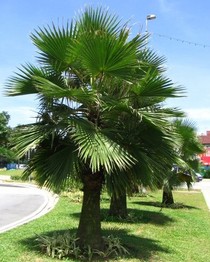
Picture of the has been licensed under a GFDL
Original source: Own work
Author: Oroussei
Permission: GNU Free Documentation License
Original source: Own work
Author: Oroussei
Permission: GNU Free Documentation License
Guadalupe Palm
The entire native population consists of old trees with little successful recruitment for 150 years or so. Until recently, Guadalupe Island supported a large goat population . The presence of these goats prevented regrowth of the native trees, including B. edulis, and as a consequence, the ecosystem was drastically altered: the once verdant island turned an almost barren rock, with weeds replacing the former forests. Below 800–900 m ASL the palm is essentially the only remaining tree, occurring in a major subpopulation and scattered groups in sheltered locations. Above that, there used to be a band of mixed woodland where the palm was accompanied by Island Oak and Guadalupe Pine. This habitat has now all but disappeared due to the other trees becoming pushed back into higher regions.Adaptation: Guadalupe palms thrive in dry, sunny climates, and do not like humid tropical conditions. The palms grow well in many parts of California and are hardy to at least 20 More
Guadalupe Palm- Brahea Edulis Guadalupe Palms are a small fan palm growing to 30ft high with a highly fissured trunk 1-1/2 feet in diameter. The large fan-shaped leaves are a shiny green and usually have an indentation along the midrib. More
